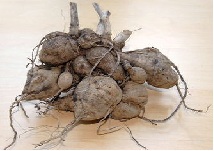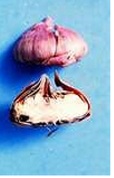We’ve probably done this before but again the question has popped up as to what is the difference between bulbs, corms, tubers and rhizomes. Most of us know a bulb from a tuber and so we call a bulb a bulb and lump all the rest under tuber. That’s fine. We all know what we are dealing with so there is no confusion. If, however, you want the technical definitions here they are. Most of the information was verified with the University of Illinois County Extension Service but some of it is stuff I just tossed in from experience.
 The best explanation of a bulb that I have ever heard is that it is a plant in waiting. A bulb contains an entire plant including a flower bud, if the bulb is to bloom in the spring. At the base of a bulb is a basal plate. This produces the roots. The outer portion of the bulb is the scales, which contain the stored food that the bulb uses until it can start to photosynthesize. These scales can have a covering (tunicate bulbs) that protects the bulb from drying out or be without this covering (imbricate bulb). Imbricate bulbs must be kept moist when stored or they will dry out. They are the ones that are generally stored in peat moss or other protection.
The best explanation of a bulb that I have ever heard is that it is a plant in waiting. A bulb contains an entire plant including a flower bud, if the bulb is to bloom in the spring. At the base of a bulb is a basal plate. This produces the roots. The outer portion of the bulb is the scales, which contain the stored food that the bulb uses until it can start to photosynthesize. These scales can have a covering (tunicate bulbs) that protects the bulb from drying out or be without this covering (imbricate bulb). Imbricate bulbs must be kept moist when stored or they will dry out. They are the ones that are generally stored in peat moss or other protection.
If you cut a true bulb, such as an onion or a tulip in half, you will see the shoot in the center. The embryonic leaves and flower bud are there, also. When the bulb starts to grow these will elongate and grow out the top of the bulb. Bulbs generally reproduce by bulblets found at the base of the main bulb. These should be removed periodically to produce new plants. The strength from the main bulb will go into producing these bulblets and they will often continue to drain the main bulb if they are not removed. Examples of bulbs are lilies, daffodils, and tulips.
 There are two types of tubers. Tuberous begonias, cyclamen and potatoes are tubers that are formed from stem tissue. The stem tissue develops underground into a storage area for starch. There are also cells present that, under proper hormonal stimuli, develop into roots and stems. If you cut a true tuber you will see only the storage tissue. You can cut a tuber into as many pieces as there are “eyes” and each part will produce a plant.
There are two types of tubers. Tuberous begonias, cyclamen and potatoes are tubers that are formed from stem tissue. The stem tissue develops underground into a storage area for starch. There are also cells present that, under proper hormonal stimuli, develop into roots and stems. If you cut a true tuber you will see only the storage tissue. You can cut a tuber into as many pieces as there are “eyes” and each part will produce a plant.
 Root tubers are also tubers but the storage tissue comes from the root not the stem. Dahlias and daylilies are examples of root tubers. At the top of the cluster of root tubers is a portion of the stem that is the growth point. The plant will only grow from this point and unless there are two or more of them the plant cannot be divided. The root tissue will not produce a growth point if removed from the plant and so cannot grow into a plant. Daylilies are sometimes considered to be fleshy roots but the principle appears to be the same.
Root tubers are also tubers but the storage tissue comes from the root not the stem. Dahlias and daylilies are examples of root tubers. At the top of the cluster of root tubers is a portion of the stem that is the growth point. The plant will only grow from this point and unless there are two or more of them the plant cannot be divided. The root tissue will not produce a growth point if removed from the plant and so cannot grow into a plant. Daylilies are sometimes considered to be fleshy roots but the principle appears to be the same.
 Rhizomes are modified stems that grow horizontallytissue just under the surface of the soil. At every node or growth point they can grow leaves or roots. Rhizomes are more a way of growing and propagating than a means of storing food to carry a plant through the winter as bulbs and tubers do. Bearded irises are an example of a large rhizome. This type of rhizome needs to be divided frequently, as they will crowd themselves out. Each growth point will make a new plant. Cannas and bamboo are also rhizomes.
Rhizomes are modified stems that grow horizontallytissue just under the surface of the soil. At every node or growth point they can grow leaves or roots. Rhizomes are more a way of growing and propagating than a means of storing food to carry a plant through the winter as bulbs and tubers do. Bearded irises are an example of a large rhizome. This type of rhizome needs to be divided frequently, as they will crowd themselves out. Each growth point will make a new plant. Cannas and bamboo are also rhizomes.
 Few people actually use the term corm but corms do differ from bulbs and tubers. A corm is a section of underground stem tissue that is modified to store starch. Unlike a bulb the leaf, stem and flower structures are not already formed. There are undifferentiated cells that can become these structures. This is similar to a tuber but only one plant will come from each corm. Gladioli and crocus are both corms. In corms large enough to differentiate tops from bottoms, the bottoms will be convex and will produce the root. The tops are concave and will produce a stem. Just toss them in the holes they don’t care which end is up.
Few people actually use the term corm but corms do differ from bulbs and tubers. A corm is a section of underground stem tissue that is modified to store starch. Unlike a bulb the leaf, stem and flower structures are not already formed. There are undifferentiated cells that can become these structures. This is similar to a tuber but only one plant will come from each corm. Gladioli and crocus are both corms. In corms large enough to differentiate tops from bottoms, the bottoms will be convex and will produce the root. The tops are concave and will produce a stem. Just toss them in the holes they don’t care which end is up.
While knowing the names of these things doesn’t seem important, it is important to know what you have so you know how to handle it. You can’t plant a piece of a daylily root (a tuberous root or fleshy root) and expect to get a plant unless there is a fan of leaves present. Rhizomes can be divided and will grow as long as each piece has a growth point. Lily bulbs (imbricate bulbs) must be kept moist because they have no protective covering and true bulbs produce bulblets that must be plated separately from the main plant. Knowing what you have can help avoid cultural mistakes.